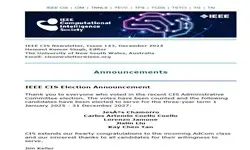Fuzzy Rule-Based Classifier Design: Accuracy, Interpretability and Explanation Ability
Hisao Ishibuchi
-
Members: FreeCIS
IEEE Members: Free
Non-members: FreeLength: 00:58:07
08 Oct 2019
Hisao Ishibuchi, Southern University of Science and Technology (SUSTech), Shenzhen, China (hisao@sustech.edu.cn)
Abstract: Fuzzy rule-based system design involves conflicting objectives such as interpretability maximization and accuracy maximization. For example, linguistic interpretability of fuzzy rule-based systems can be improved by decreasing the number of fuzzy rules, the number of antecedent conditions in each fuzzy rule, and the complexity of fuzzy partition for each input variable. However, those interpretability improvement efforts often degrade the accuracy of fuzzy rule-based systems. That is, very simple fuzzy rule-based systems with high linguistic interpretability usually do not have high accuracy. In the 1990s, conflicting objectives were combined into a single integrated objective function, which was optimized by a single-objective optimization algorithm. Currently those objectives are handled as different objectives and simultaneously optimized by an evolutionary multi-objective optimization (EMO) algorithm. A large number of non-dominated fuzzy rule-based systems can be obtained by a single run of an EMO algorithm. In this talk, we focus on fuzzy rule-based classifier design. This talk starts with a brief review of well-known highly-cited studies related to fuzzy rule-based classifier design from two viewpoints: Accuracy maximization and interpretability maximization. Next, fuzzy rule-based classifier design is explained as multi-objective optimization problems to which EMO algorithms are applied. Then, we discuss the explanation ability of fuzzy rule-based classifiers, which is the ability to explain in a human understandable manner why an input pattern is classified as an output class. Finally, we discuss future research directions in fuzzy rule-based classifier design including deep fuzzy classifiers.
Abstract: Fuzzy rule-based system design involves conflicting objectives such as interpretability maximization and accuracy maximization. For example, linguistic interpretability of fuzzy rule-based systems can be improved by decreasing the number of fuzzy rules, the number of antecedent conditions in each fuzzy rule, and the complexity of fuzzy partition for each input variable. However, those interpretability improvement efforts often degrade the accuracy of fuzzy rule-based systems. That is, very simple fuzzy rule-based systems with high linguistic interpretability usually do not have high accuracy. In the 1990s, conflicting objectives were combined into a single integrated objective function, which was optimized by a single-objective optimization algorithm. Currently those objectives are handled as different objectives and simultaneously optimized by an evolutionary multi-objective optimization (EMO) algorithm. A large number of non-dominated fuzzy rule-based systems can be obtained by a single run of an EMO algorithm. In this talk, we focus on fuzzy rule-based classifier design. This talk starts with a brief review of well-known highly-cited studies related to fuzzy rule-based classifier design from two viewpoints: Accuracy maximization and interpretability maximization. Next, fuzzy rule-based classifier design is explained as multi-objective optimization problems to which EMO algorithms are applied. Then, we discuss the explanation ability of fuzzy rule-based classifiers, which is the ability to explain in a human understandable manner why an input pattern is classified as an output class. Finally, we discuss future research directions in fuzzy rule-based classifier design including deep fuzzy classifiers.


